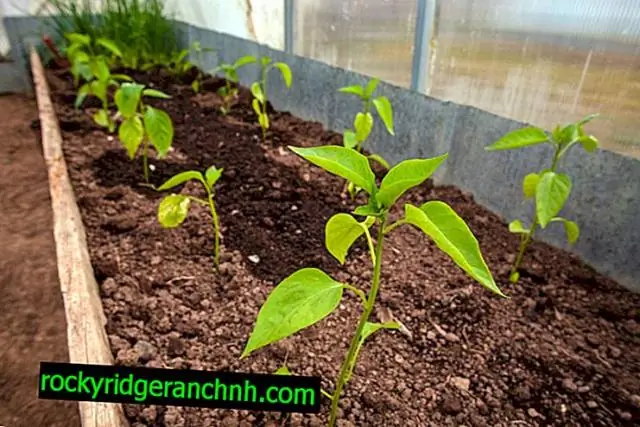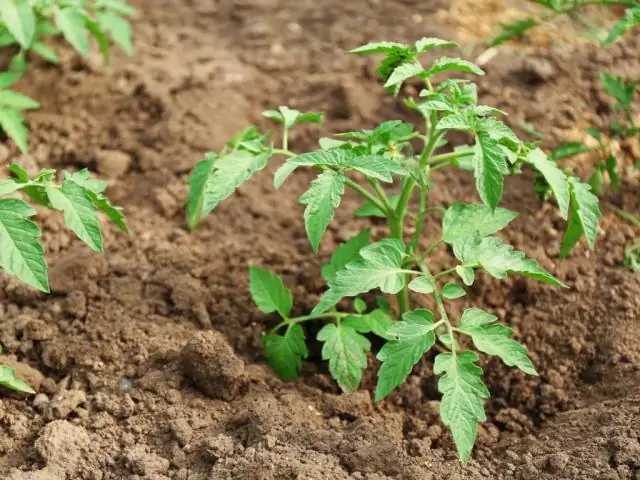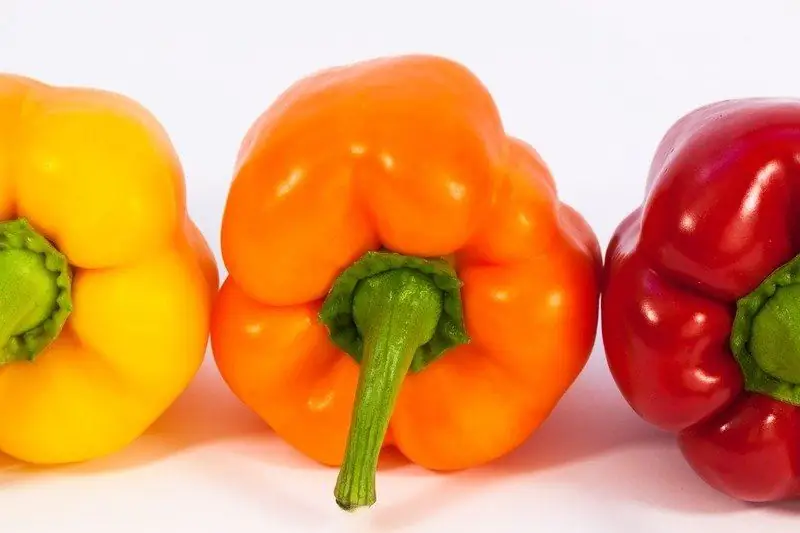
Table of contents:
- We grow eggplant seedlings at home
- Is it necessary to grow eggplants through seedlings
- When to plant seeds in 2019 according to the lunar calendar
- Preliminary preparation
- Growing eggplant seedlings at home
- Is a pick mandatory
- Useful Tips
- Features of growing eggplant seedlings in different regions of Russia
- Author Bailey Albertson [email protected].
- Public 2023-12-17 12:53.
- Last modified 2025-06-01 07:32.
We grow eggplant seedlings at home

Eggplants differ from other similar crops by their increased thermophilicity, as well as a long growing season. Therefore, it is possible to grow them without seedlings, by directly sowing seeds in a garden bed, only in the warmest regions. And start growing seedlings earlier than most other vegetables. It is quite simple to do this at home, but there are some nuances.
Content
- 1 Is it necessary to grow eggplants through seedlings
- 2 When to plant seeds in 2019 according to the lunar calendar
-
3 Preliminary preparation
- 3.1 Seed preparation
- 3.2 Soil preparation
-
4 Growing eggplant seedlings at home
- 4.1 How to plant and grow in a city apartment
- 4.2 In the greenhouse
- 4.3 Planting in peat pots
- 4.4 Use of peat tablets
- 4.5 Germination of eggplants in the "snail"
- 5 Is picking mandatory
-
6 Helpful Tips
6.1 Video: tips for growing eggplant seedlings
- 7 Features of growing eggplant seedlings in different regions of Russia
Is it necessary to grow eggplants through seedlings
The agricultural technology of eggplants is very similar to the agricultural technology of the Bulgarian (sweet) pepper, and the differences in their cultivation are insignificant. They are connected with the fact that eggplant is an even more thermophilic crop, and the growing season for eggplant is somewhat longer than that of pepper. Therefore, it is almost impossible to grow eggplants without seedlings anywhere.
If in the southernmost regions of our country sowing eggplants in the spring immediately in the garden, you can have time to get the harvest, but it will be late, and the total number of fruits is lower than when planting seedlings. Therefore, even in the south, this is almost never done. True, there is no need to force the windowsills with pots, you can grow seedlings in small greenhouses. And in central Russia, in the absence of good greenhouses, you have to deal with seedlings at home, and you need to start these worries already in winter.
When to plant seeds in 2019 according to the lunar calendar
Eggplant seeds germinate slowly: if they are sown unprepared, seedlings will have to wait up to 15 days, and properly prepared ones will sprout a little faster. Before planting in a garden bed, seedlings should grow in pots for at least two months, and from the time of sowing the seeds to the beginning of flowering of most eggplant varieties, it takes almost four months. Therefore, it is necessary to sow eggplant seeds in the central regions already in mid-February, and in the south, sowing is sometimes carried out even in January.
A couple of decades ago, or even a little earlier, summer residents began to follow the publication of various astrological forecasts and their accompanying lunar calendars, which prohibited any gardening work on certain days and considered it optimal for planting various crops only a few days in each month. This is due to certain phases of movement of the celestial bodies and, mainly, the Moon. Now this fashion is slowly waning, but many gardeners still trust the Lunar calendar, especially if they have the opportunity to do so.
It is difficult to say to what extent this is justified, but the fact that the lunar cycle in a certain way affects the life of plants cannot be questioned. If the heavenly bodies affect human health, then why the same was not the case in the case of plants? The trouble is that in different sources the lunar calendars differ, sometimes very much. Therefore, if you adhere to certain rules, you need to review many publications and conduct a thorough analysis.
So, some calendar options for 2019 advise sowing eggplants on February 14-16 and March 13-15. Others are more supportive and increase the number of days: they allow this to be done on February 4-8, 18, 23 and March 20-24. As you can see, the days don't even overlap. Turning to the following sources, we begin to understand that all this is "from the evil one" and we calm down: we work when there is time, desire, and the sowing time has come, dictated by many years of experience.
Preliminary preparation
As with growing any seedlings, you need to stock up on reliable seeds, convenient containers and good, nutritious soil. From the point of view of packaging, there are no questions for eggplants: they must be grown in separate pots, not the smallest size, preferably peat ones, since they do not like transplanting. But first, you can sow in a common box or box to save space for a while, and then carefully plant the best specimens.
Seed preparation
You should start preparing eggplant seeds already in winter, at least sort out the varieties and purchase those that are suitable for a specific region. If in the south you can grow any varieties and hybrids, then in other regions you need to carefully look at what the seeds are for: for greenhouse cultivation or unprotected soil. In the open ground in the middle lane, only early and very early varieties and hybrids can be planted.
Since the seeds germinate for a long time, and the seedlings grow slowly, in mid-February it is time to deal with the seeds and start preparing them for sowing. And if they were bought several years ago, two weeks before that, it is worth checking them for germination. To do this, a dozen seeds (although, of course, now they put only a dozen in a bag!) After soaking, they try to germinate on a wet cloth in the warmth. If half hatch within a week at 30 ° C, it's good.

Eggplant seeds are very similar to tomato seeds.
In our time, purchased fresh seeds from well-known companies do not need to be disinfected: now seed-growing organizations are fighting for an honest name and are trying to sell only high-quality goods. But if in doubt, the seeds should be dipped in a dark solution of potassium permanganate for half an hour, and then washed with clean water. Eggplants are afraid of the slightest cold snaps, so it makes sense to harden the seeds by placing them in a damp cloth and periodically moving them from a warm room to the refrigerator and vice versa for 4-6 days.
On the day before sowing, it is worth treating the seeds with a growth stimulant (Epin-Extra, Zircon, etc.). Detailed instructions for the drugs must be on the package, it must be followed. And if, for example, this operation is completely optional for tomatoes, it only takes time and money, in the case of eggplants it is better not to neglect it: they will grow better and grow faster.
Soil preparation
Ready-made potting mixes for seedlings of a wide variety of vegetables and flowers are sold in the respective stores. As a rule, they are compiled based on the characteristics of the culture, but you can also run into an obvious hack: ordinary soil poured into a bag. This is especially likely in the case of inexpensive mixtures. And the good ones are expensive. If it is supposed to grow no more than a dozen roots, it makes sense to buy ready-made soil, but only if eggplants are indicated in its purpose. In this case, preparation is not required, although you can hold the package for a couple of days in the cold.

If the package has the word "eggplant", you can take
For the most part, summer residents are not so rich, and they try to prepare potting mixes from available ingredients. It is good if ordinary peat is not a problem in your region: on its basis, the best soil for sowing eggplants is obtained. If you mix it in half with turf soil and add a little coarse sand, you can do without fertilizers at first, then replenishing the supply of nutrients with dressings. But it is better to immediately add 10-30 g of any nitrogen, phosphorus and potash fertilizers to a bucket of soil. Or a little urea and 150 grams of wood ash.
Self-prepared soil should be disinfected. Someone steamed it in the oven, someone ignited it on a baking sheet, but at high temperatures, not only pathogens but also useful microflora perish! It seems that it is still optimal to pour the soil a few days before using a pink solution of potassium permanganate. The finished mixture should be placed in a box with a layer of about 8 cm and lightly tamped.
Growing eggplant seedlings at home
Unlike, for example, cabbage, which is hot in an apartment, eggplant seedlings, if there is not much of it, are convenient to grow on a windowsill: blue ones need warmth. When growing a large amount, of course, you need a greenhouse, but only a heated one: in February, in an ordinary greenhouse, it is almost the same winter as outside.
How to plant and grow in a city apartment
Most often, the seeds are first sown in small boxes, there are no nuances in this sowing. Since the seeds are medium-sized eggplants, you can easily sow them one at a time at the desired distance, the most convenient scheme is 5 x 5 cm. If it is convenient to outline shallow grooves, you can do so. Or outline the holes, whichever is easier. Seeds are usually taken with tweezers and placed to a depth of about 1.5 cm. Or you can simply spread them over the surface, and then cover them with a half-centimeter layer of soil. If there are a lot of seeds, you can sow more often, and thin out after the emergence of seedlings, but good hybrids are expensive, it is better to save money.
Crops must be well watered. This is the only case when warm water is not required. Moreover, since it is February, it is better to put a few centimeters of snow on the surface of the soil: it will not wash out the soil during thawing, it will saturate it well, and there is something in the snow water that contributes to better seed germination. The box must be covered with glass or foil and placed in a warm place: a temperature of 25-28 ° C is needed before germination. If the soil dries up, you can freshen it up with a spray bottle. Seedlings should appear in 7-10 days.

Eggplant seedlings resemble tomato or pepper seedlings
Once the eggplants have hatched from the ground, they need good light. For the first week, the temperature should be lowered to 14-16 ° C so that the seedlings do not stretch out and the roots grow better. Then the temperature is raised (but not abruptly) to 23-25 ° С during the day and 18-20 ° С at night.
There is nothing complicated in the further mode: you need to monitor the temperature and, if there is little light, additionally illuminate the seedlings with a fluorescent lamp or a special phytolamp. If the light falls from the side, the box must be periodically turned towards it. It is enough to water once a week, but with settled warm water (no colder than 25 ° C). Better to dry out than overflow! Stagnation of water in a box threatens the most dangerous disease - a black leg, eggplants are very afraid of it. For the first month, if the soil was prepared correctly, one top dressing is enough: as soon as it seems that growth has slowed down, dissolve a teaspoon of urea in 5 liters of water and water well.
Eggplant seedlings grow tight and unevenly: some seedlings can greatly outstrip others in development. Therefore, the pick is done selectively. It is carried out in the phase of two well-formed true leaves. Specimens that are clearly lagging in growth can be removed immediately. Before diving, the soil is well watered, the seedlings are taken out individually and very carefully. The pots should not be too small, preferably almost liter. The soil is the same as in the box. The pick is carried out as usual, making a depression in the soil with any convenient object. Eggplant roots are not specially pinched (as, for example, in tomatoes), but you do not need to suffer from the fact that they were damaged during transplantation: if the root is very long and interferes with planting, it can be shortened a little, but if you managed to dig out a seedling with a good lump of earth, it is better to plant it that way.
Seedlings in pots are watered with warm water (without excess) and shaded a little for the first few days. In the future, continue to keep warm, watering as needed. Top dressing is carried out if required. If the seedlings grow slowly, and the leaves are not very brightly colored, they must be watered with a weak solution of complex mineral fertilizer. It is very useful to gently pour some wood ash to the roots a couple of times in the remaining month (without getting on the leaves).
At the end of spring (depending on the weather), the seedlings must be hardened, briefly taking them out to the balcony. Seedlings are ready for transplanting into the garden if they have a strong appearance, have reached a height of 20-25 cm and have grown at least 5 (or better 6-8) large green leaves.

Good seedlings are perfectly viable plants
There are almost no drawbacks in growing eggplant seedlings at home: the only one is that it takes up a lot of space. But the temperature conditions of a city apartment and the ability to monitor the condition on a daily basis allow us to agree that this is the best option.
In the greenhouse
In the south, they try to sow eggplants for seedlings in the greenhouse, but in other regions this is possible only if the greenhouse is heated. And, of course, it should be available to the gardener every day: visiting seedlings only on weekends is not an option. Growing seedlings in greenhouse conditions consists of the same operations as at home, a slight difference can only be in the timing of sowing seeds, which depend on the weather and the quality of the greenhouse. In a heated greenhouse, work can be started even in January, but in a normal greenhouse it will still not work to grow eggplant seedlings by the deadline.
The temperature regime for growing eggplants is the same as in the apartment. However, the greenhouse must be systematically ventilated: in still air there is a greater risk of seedling diseases.
Usually eggplants are also grown in a greenhouse in a box-pot method, but here you can also build beds if the soil temperature allows. It is most convenient to sow in a box, like at home, and then spread the seedlings to the garden bed. And if the further stay of the eggplants in the greenhouse is assumed, until the end of the harvest, then it will be more correct to dive straight to a permanent place. But the bed must be prepared in the fall: all the garbage is removed, the soil is fertilized (and perhaps completely changed). And in the spring, the soil in the garden bed should be disinfected by spilling with a weak solution of potassium permanganate or copper sulfate.

It makes sense to grow only a large number of seedlings in a greenhouse.
Thus, it is worth recognizing that the cultivation of eggplant seedlings in a greenhouse is hardly possible for an ordinary summer resident of central Russia: this is possible in large agricultural enterprises, since the greenhouse must be heated, and care for the seedlings is required daily.
Planting in peat pots
Disposable peat pots were made in ancient times by a handicraft method, and for several decades they have been produced by industry. They are made from compressed peat, adding fertilizers and other useful components to it. They are made in different shapes and sizes, but the largest ones should be taken for eggplants.
The advantages of peat pots over ordinary (paper or plastic) pots are obvious:
- you do not need to get seedlings out of them when planting in the garden: they are planted together with a pot, and the roots easily penetrate the walls;
- when transplanting, the roots do not break, the seedlings continue to grow almost without interruption;
- the material of the pots (peat) also serves as a fertilizer.
The relative inconvenience of using such pots is that the pots become soaked and softened from watering. Therefore, they must be immediately installed in the pallet and, if possible, not taken in hand until transplanting into the garden. There is another danger: if the pots are too small, the roots of the seedlings may grow through the walls ahead of time and get mixed up with each other, this must be monitored. In addition, it must be borne in mind that there are pots with different wall thicknesses, and some plants can hardly penetrate thick layers with their roots. For eggplant seedlings, pots with walls of medium thickness are needed.

Peat eggplant pots should be chosen from among the largest
Despite the fact that the material of the pots is water-permeable, it is better to pre-pierce several holes in the bottom so that excess water flows out of them as soon as possible: the pots themselves will be more intact. Caring for seedlings in pots does not have any essential features. You may only need to water the eggplant a little more often than when using plastic containers.
Is it possible immediately, without picking, to sow seeds in peat pots? Of course you can, but it makes little sense. Based on the fact that the germination rate will not be 100%, you will have to sow at least two seeds, and this is an overrun. We'll immediately take up a lot of space on the windowsill. And the material of the pots can hardly withstand being damp for two months. Therefore, the primary sowing in boxes with subsequent picking into pots is still reasonable.
With the right choice of material and size of pots and their correct use, the number of pluses significantly exceeds the number of conditional minuses. True, you need to buy them annually, unlike plastic ones.
Use of peat tablets
Besides growing in pots, the use of peat tablets is popular. The tablets are convenient for growing seedlings of those crops that do not respond well to transplantation. The tablets are made from peat with the addition of various nutrients. They are enclosed in a light shell that prevents peat from scattering. The shelf life of tablets is not limited. Previously, the tablets are placed in a tray and gradually filled with water. At the same time, they grow several times in height, almost without changing the diameter.
A small recess is made in one of the ends of the tablet, into which the seed is placed: with this end, the tablets are put up. Obviously, when using tablets, picking is not provided, but transplanting a plant together with a tablet into a larger pot as the seedlings grow is possible: after all, large containers are needed for eggplants, and the largest tablets have a diameter of only 70 mm.
When sowing in tablets, the timing can be slightly shifted, since without picking the seedlings will grow a little faster. After sowing the seeds, the pallet is covered and placed in a warm place. Then everything is as usual. Only pills are poured "through the bottom": water is poured into the pan, and it is absorbed in the required quantities. Top dressing for tablet growing is not needed.

Peat tablets are ideal nutrient containers for seedlings
The use of peat tablets is very convenient, there is only one minus: the extra cost of money. But if you need to grow only a few copies of eggplant seedlings, the advantages of the tablets will reliably cover their disadvantages.
Sprouting eggplants in a "snail"
Seedlings of some fast-growing types of vegetables can be grown in a "snail" until they are planted in a vegetable garden. Such a number does not work with eggplants, but for a while you can use this clever trick to save space on the windowsill. It will be easy to extract seedlings from the snail for subsequent picking into ordinary pots. The order of operations is as follows:
- Cut out a strip of dense sheet material, such as linoleum or bubble wrap. The width will be about 15 cm, the length is from a meter.
- After spreading the strip on the table, put several layers of ordinary toilet paper on it, and then pour the fertile soil with a layer of about 1.5 cm and level it.
- We spread the eggplant seeds along one of the long sides: 1-1.5 cm from the edge, with a distance of 4-5 cm between the seeds.
-
We cover the soil with another layer of toilet paper and roll the structure into a roll, tying it with an elastic band or rope.

Eggplant snail Of course, the seedlings will be cramped in the snail, but this is only a temporary dwelling for eggplants.
- We put the "snail" in the pallet with the seeds up, cover with a plastic bag.
- We place the pallet in the heat and wait for the shoots, after which we grow the seedlings before picking in this snail.
Growing principles are the same: temperature conditions, moderate humidity, good lighting. Plus, perhaps one: compactness. But since the eggplant in the snail will soon become cramped, the disadvantages of this approach are also obvious, and therefore this tricky technology is rarely used in the case of eggplant.
Is a pick mandatory
If picking is considered mandatory for tomatoes (although, of course, they grow without it, but picking allows you to get a more powerful root system), then for eggplant related to them this is not at all the case. It is best to grow them without picking at all, sowing immediately into separate pots, but this is rarely done only for reasons of space saving: all horizontal surfaces in the house must be occupied for almost three months. And since a neat transplantation of eggplants is tolerable, seedlings are grown most often through the stage of a common box, with a pick.
Eggplants ready for picking should have two healthy true leaves: earlier picking is undesirable for them, and if it is urgently required, picking should be carried out with minimal root damage. When transplanting in the two-leaf stage, they try not to disturb the root system, but if the central root has managed to grow too long, it is slightly pinched: this is better than bending it in the hole. It is not necessary to deepen the seedlings when diving too much: they do this only if they have managed to stretch out strongly. If the seedlings look normal, they are transplanted into pots almost to the cotyledonous leaves, but still without burying them.

When diving, it is advisable not to disturb the earthen coma and the eggplant root system
Useful Tips
If you follow all the rules, even a novice gardener can grow strong eggplant seedlings. But problems can lie in wait at any moment, including not very pleasant ones. Most of them are solvable:
- It may be that two weeks have passed, but there are no shoots. If the seeds and soil were of good quality, the seeds may just be chilly. Try to raise the temperature to 30 o C. If after 3-4 days they have not hatched, then the seeds have already disappeared; before it's too late, sow again.
- The seedlings are stretched out. Everything is clear here: either there is little light, or too hot - the seedlings grow out in the first 7-10 days after germination, when lower temperatures and maximum light are required. In later stages, stretching only occurs from over-landing in the box. If it is not yet fatally stretched, you can try to gently add soil up to the cotyledons and correct the light and temperature conditions. If the cotyledons are already 5 centimeters long, it's a bad thing, you will have to throw it away.
- Yellowing of the leaves may indicate a lack of nutrition or improper moisture regime: both excess and lack of watering (we do not consider bad soil: this can be anything). If everything is in order with humidity, you should try to feed.
-
Seedlings wither and die: first, 1-2 copies, then more. It's almost certain that things are bad. It looks like a black leg. The reason is either an introduced infection, or too much moisture. If things have not gone far, you can try to remove diseased specimens, water the soil with a pink solution of potassium permanganate and add dry, clean sand to the roots. Sometimes it helps. And keep a close eye on what happens next.

Black leg seedling With a black leg, the stems turn black and dry
Video: tips for growing eggplant seedlings
Features of growing eggplant seedlings in different regions of Russia
The technology of growing eggplant seedlings as a whole does not depend on the region. Only the time and place differ: if in the south it can be done in an unheated greenhouse or greenhouse, in other areas the greenhouse must be heated, otherwise the work must be carried out in an apartment.
So, if in the Moscow region they are going to plant eggplants in a greenhouse, then the seeds are sown at home at the end of February. But if they want to take a chance and plant in open ground (and this can be done only in early June), then there is no point in rushing with seedlings: sowing can be carried out in the second half of March, simultaneously with tomatoes.
In most regions and territories of Siberia, summer is quite warm, but its duration is short. Therefore, it is possible to grow eggplants in the open field only using the earliest ripening hybrids. Seedlings are planted in mid-June. More often this is done in greenhouses, and if this is a modern polycarbonate greenhouse, then the landing is planned for mid-May. From these dates, the time of sowing seeds for seedlings is calculated: the end of March or the end of winter.
In most localities in the Urals, the climate is similar to that of Siberia, and the principles of truck farming are very similar. Rarely does anyone try to get a normal harvest outdoors, although this is possible in the case of zoned varieties. Mostly eggplants are planted in a greenhouse, and seedlings are grown at home, starting this process in late winter or early spring.
Growing eggplant seedlings resembles the same process in the case of related peppers or tomatoes, only the timing is slightly shifted. Eggplants have to be in pots for a long time, since planting them in the garden is possible only with the arrival of the real summer, and the seedlings grow slowly, especially at first. Nevertheless, there are no particular difficulties in growing seedlings, and any, even a beginner, gardener can cope with this process.
Recommended:
Seedling Cucumbers At Home: When To Plant In According To The Lunar Calendar, Growing Methods, Rules Of Care

When and how to sow cucumber seeds to get seedlings on time at home, what techniques help in this matter, how to avoid offensive mistakes
When To Plant Peppers For Seedlings In 2019: General Dates And Lunar Calendar

When to sow peppers for seedlings: terms, taking into account the lunar calendar and the characteristics of the region
Growing Pepper Seedlings At Home: When To Plant According To The Lunar Calendar 2019, On The Windowsill, In The Greenhouse And Not Only With Video

How to prepare everything you need for growing pepper seedlings at home, sow seeds and grow in a suitable way for a gardener
How To Grow Cabbage Seedlings At Home In Different Ways: When To Sow, Features Of Care With Video, Lunar Calendar

How to grow cabbage seedlings at home: rules for preparing seed and soil, especially sowing and care
Seedling Of Petunias At Home: When To Plant In According To The Lunar Calendar, Methods Of Growing, Rules Of Care

Do I need to grow petunia seedlings at home, what problems await, is it possible to overcome them
